Entrepreneurial Journey: Analyzing Alan Sugar's Success with the Timmons FORT Model
VerifiedAdded on 2024/05/23
|8
|2034
|487
AI Summary
Contribute Materials
Your contribution can guide someone’s learning journey. Share your
documents today.
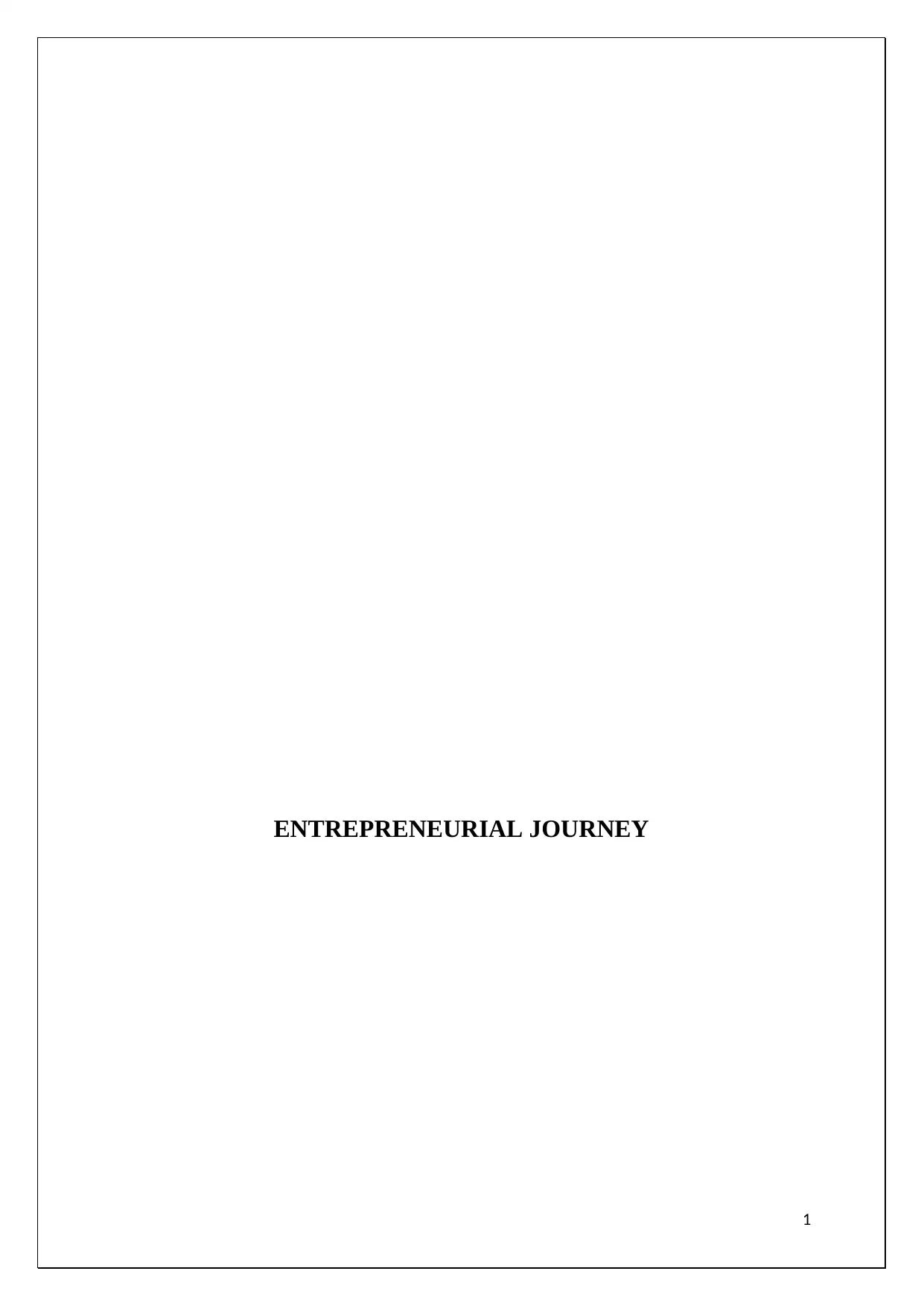
ENTREPRENEURIAL JOURNEY
1
1
Secure Best Marks with AI Grader
Need help grading? Try our AI Grader for instant feedback on your assignments.
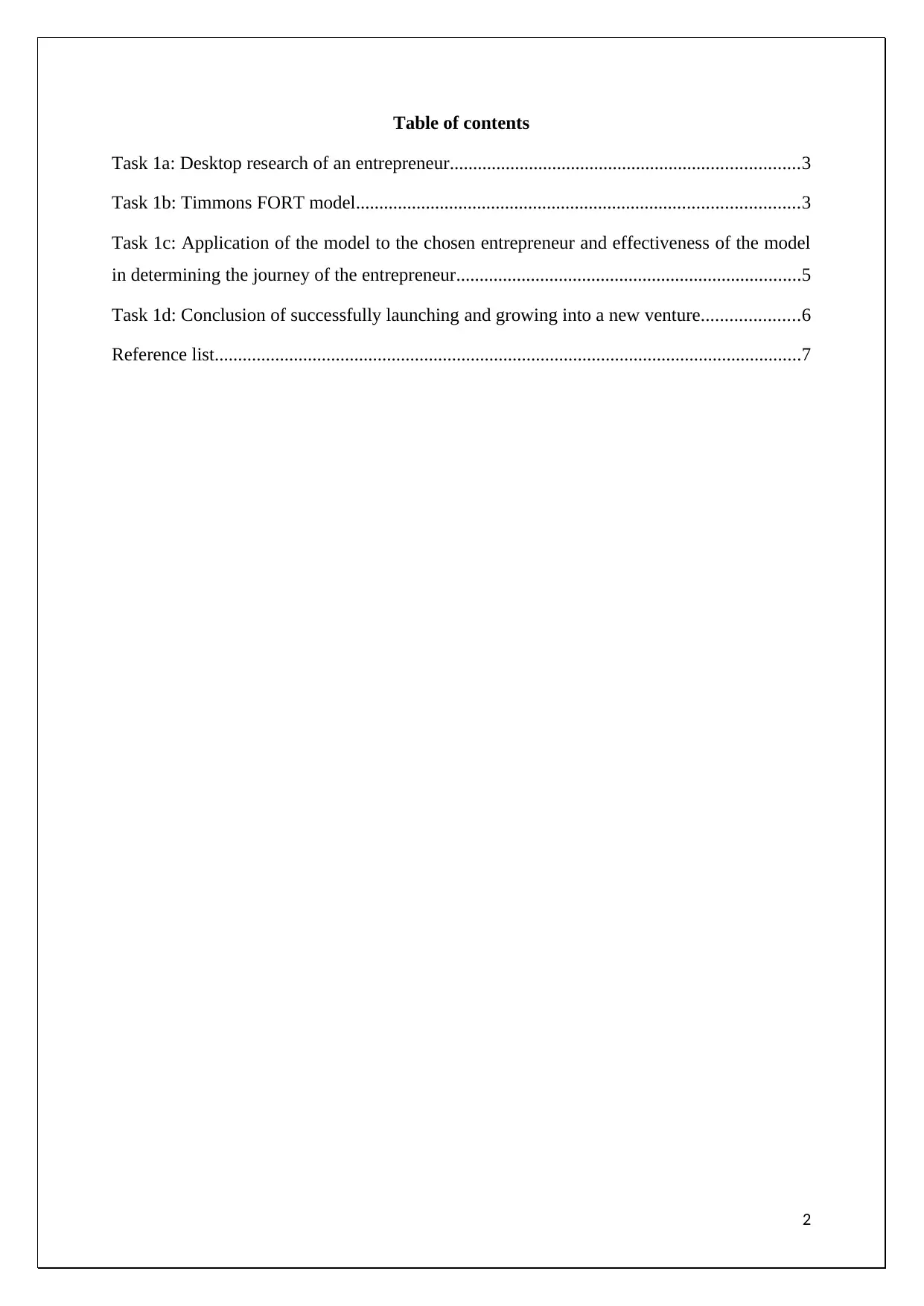
Table of contents
Task 1a: Desktop research of an entrepreneur...........................................................................3
Task 1b: Timmons FORT model...............................................................................................3
Task 1c: Application of the model to the chosen entrepreneur and effectiveness of the model
in determining the journey of the entrepreneur..........................................................................5
Task 1d: Conclusion of successfully launching and growing into a new venture.....................6
Reference list..............................................................................................................................7
2
Task 1a: Desktop research of an entrepreneur...........................................................................3
Task 1b: Timmons FORT model...............................................................................................3
Task 1c: Application of the model to the chosen entrepreneur and effectiveness of the model
in determining the journey of the entrepreneur..........................................................................5
Task 1d: Conclusion of successfully launching and growing into a new venture.....................6
Reference list..............................................................................................................................7
2
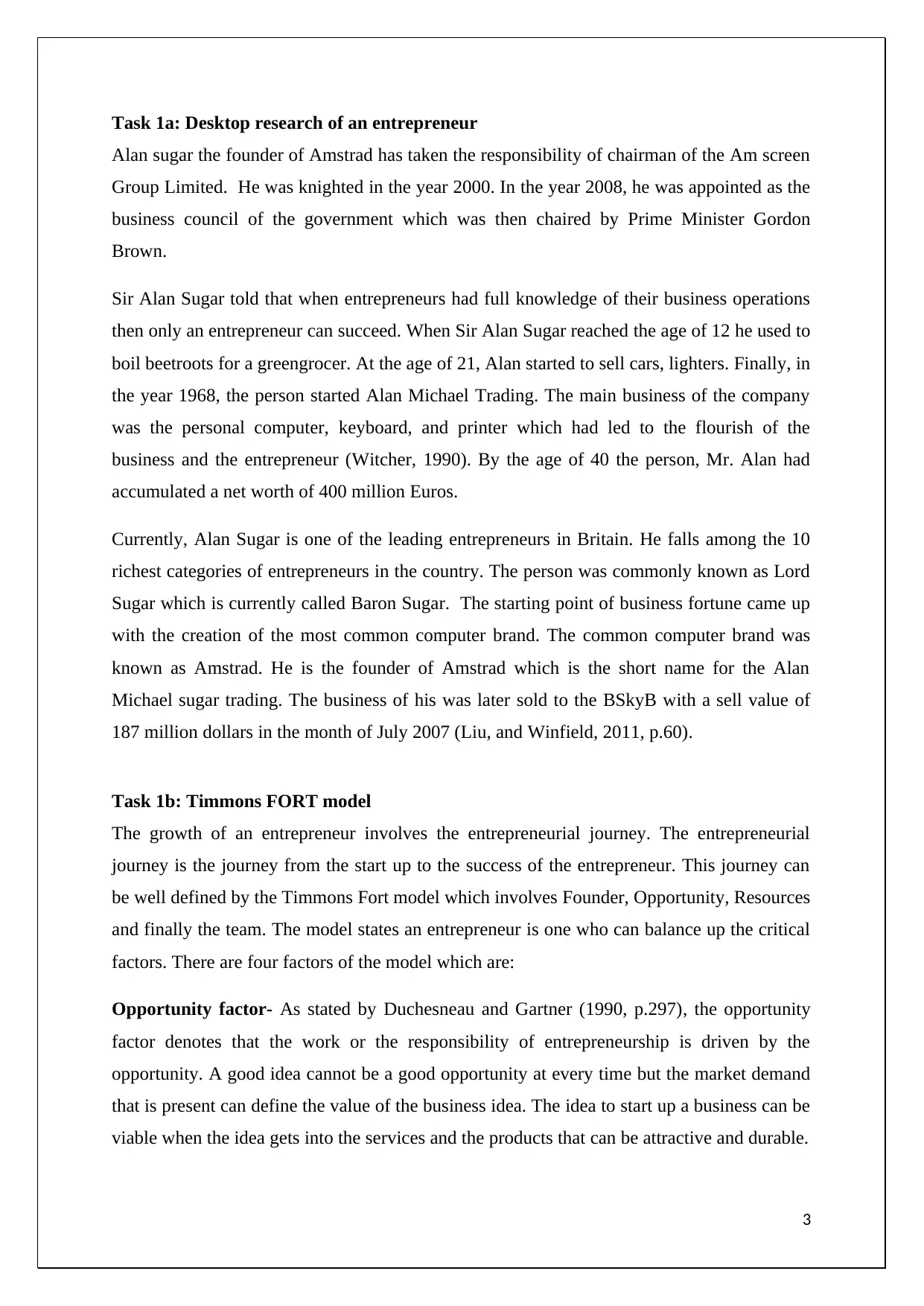
Task 1a: Desktop research of an entrepreneur
Alan sugar the founder of Amstrad has taken the responsibility of chairman of the Am screen
Group Limited. He was knighted in the year 2000. In the year 2008, he was appointed as the
business council of the government which was then chaired by Prime Minister Gordon
Brown.
Sir Alan Sugar told that when entrepreneurs had full knowledge of their business operations
then only an entrepreneur can succeed. When Sir Alan Sugar reached the age of 12 he used to
boil beetroots for a greengrocer. At the age of 21, Alan started to sell cars, lighters. Finally, in
the year 1968, the person started Alan Michael Trading. The main business of the company
was the personal computer, keyboard, and printer which had led to the flourish of the
business and the entrepreneur (Witcher, 1990). By the age of 40 the person, Mr. Alan had
accumulated a net worth of 400 million Euros.
Currently, Alan Sugar is one of the leading entrepreneurs in Britain. He falls among the 10
richest categories of entrepreneurs in the country. The person was commonly known as Lord
Sugar which is currently called Baron Sugar. The starting point of business fortune came up
with the creation of the most common computer brand. The common computer brand was
known as Amstrad. He is the founder of Amstrad which is the short name for the Alan
Michael sugar trading. The business of his was later sold to the BSkyB with a sell value of
187 million dollars in the month of July 2007 (Liu, and Winfield, 2011, p.60).
Task 1b: Timmons FORT model
The growth of an entrepreneur involves the entrepreneurial journey. The entrepreneurial
journey is the journey from the start up to the success of the entrepreneur. This journey can
be well defined by the Timmons Fort model which involves Founder, Opportunity, Resources
and finally the team. The model states an entrepreneur is one who can balance up the critical
factors. There are four factors of the model which are:
Opportunity factor- As stated by Duchesneau and Gartner (1990, p.297), the opportunity
factor denotes that the work or the responsibility of entrepreneurship is driven by the
opportunity. A good idea cannot be a good opportunity at every time but the market demand
that is present can define the value of the business idea. The idea to start up a business can be
viable when the idea gets into the services and the products that can be attractive and durable.
3
Alan sugar the founder of Amstrad has taken the responsibility of chairman of the Am screen
Group Limited. He was knighted in the year 2000. In the year 2008, he was appointed as the
business council of the government which was then chaired by Prime Minister Gordon
Brown.
Sir Alan Sugar told that when entrepreneurs had full knowledge of their business operations
then only an entrepreneur can succeed. When Sir Alan Sugar reached the age of 12 he used to
boil beetroots for a greengrocer. At the age of 21, Alan started to sell cars, lighters. Finally, in
the year 1968, the person started Alan Michael Trading. The main business of the company
was the personal computer, keyboard, and printer which had led to the flourish of the
business and the entrepreneur (Witcher, 1990). By the age of 40 the person, Mr. Alan had
accumulated a net worth of 400 million Euros.
Currently, Alan Sugar is one of the leading entrepreneurs in Britain. He falls among the 10
richest categories of entrepreneurs in the country. The person was commonly known as Lord
Sugar which is currently called Baron Sugar. The starting point of business fortune came up
with the creation of the most common computer brand. The common computer brand was
known as Amstrad. He is the founder of Amstrad which is the short name for the Alan
Michael sugar trading. The business of his was later sold to the BSkyB with a sell value of
187 million dollars in the month of July 2007 (Liu, and Winfield, 2011, p.60).
Task 1b: Timmons FORT model
The growth of an entrepreneur involves the entrepreneurial journey. The entrepreneurial
journey is the journey from the start up to the success of the entrepreneur. This journey can
be well defined by the Timmons Fort model which involves Founder, Opportunity, Resources
and finally the team. The model states an entrepreneur is one who can balance up the critical
factors. There are four factors of the model which are:
Opportunity factor- As stated by Duchesneau and Gartner (1990, p.297), the opportunity
factor denotes that the work or the responsibility of entrepreneurship is driven by the
opportunity. A good idea cannot be a good opportunity at every time but the market demand
that is present can define the value of the business idea. The idea to start up a business can be
viable when the idea gets into the services and the products that can be attractive and durable.
3

Team factor- When the entrepreneur has finished analyzing the opportunity activities the
team is made to make people work together and the financial and the nonfinancial resources
are collected. The team factor states that a team which is not efficient and good can lead to
waste or destroy a good business idea (Latessa et al. 2002, p.43). A good team can have the
potential to undergo pressures that are related to the growth. The team factor states two
important team roles which are related to the other critical factors. The roles are:
Removal of the uncertain events by creative thoughts and skills.
Giving proper leadership in order to manage the resources that are available. Such
leadership is given in the most efficient way as interactions take place with the
exogenous forces and the context of the capital market that changes from time to
time.
Resource Factor- The model gives a valid description that extensive resources of the
business have the ability to minimize the risk that can occur while starting a venture. It
encourages the bootstrapping with the minimal requirements which can be a method to obtain
competitive advantages. Bootstrapping involves different advantages which consist of:
Reduction in the market cost
Discipline and leanness in the company
Encourages the efficient and effective resource to give more with a little amount of
financial capital and other less effective resources.
They are other applications like bootstrapping which comprises of leasing items or assets,
working out the garage. Accompanied by the team building the type of opportunity can
determine the number of resources that would be required (Dellabarca, 2002). The good
resource is scaring the business which has high potential opportunities and an efficient team
will face no difficulty to attract resources.
Founder factor- Founder factor is the most important factor because the entrepreneur is the
person who coordinates and harmonizes the skills and the efforts along with the resources. As
stated by Barakat et al. (2014, p.456), the entrepreneur operates in a way to reduce the
control. The founder factor involves the proper managing of the available resources and
balance ups all the resource so that no resources are less utilized or more utilized. Besides the
founder factor is involved in the development of efficient teams.
4
team is made to make people work together and the financial and the nonfinancial resources
are collected. The team factor states that a team which is not efficient and good can lead to
waste or destroy a good business idea (Latessa et al. 2002, p.43). A good team can have the
potential to undergo pressures that are related to the growth. The team factor states two
important team roles which are related to the other critical factors. The roles are:
Removal of the uncertain events by creative thoughts and skills.
Giving proper leadership in order to manage the resources that are available. Such
leadership is given in the most efficient way as interactions take place with the
exogenous forces and the context of the capital market that changes from time to
time.
Resource Factor- The model gives a valid description that extensive resources of the
business have the ability to minimize the risk that can occur while starting a venture. It
encourages the bootstrapping with the minimal requirements which can be a method to obtain
competitive advantages. Bootstrapping involves different advantages which consist of:
Reduction in the market cost
Discipline and leanness in the company
Encourages the efficient and effective resource to give more with a little amount of
financial capital and other less effective resources.
They are other applications like bootstrapping which comprises of leasing items or assets,
working out the garage. Accompanied by the team building the type of opportunity can
determine the number of resources that would be required (Dellabarca, 2002). The good
resource is scaring the business which has high potential opportunities and an efficient team
will face no difficulty to attract resources.
Founder factor- Founder factor is the most important factor because the entrepreneur is the
person who coordinates and harmonizes the skills and the efforts along with the resources. As
stated by Barakat et al. (2014, p.456), the entrepreneur operates in a way to reduce the
control. The founder factor involves the proper managing of the available resources and
balance ups all the resource so that no resources are less utilized or more utilized. Besides the
founder factor is involved in the development of efficient teams.
4
Secure Best Marks with AI Grader
Need help grading? Try our AI Grader for instant feedback on your assignments.
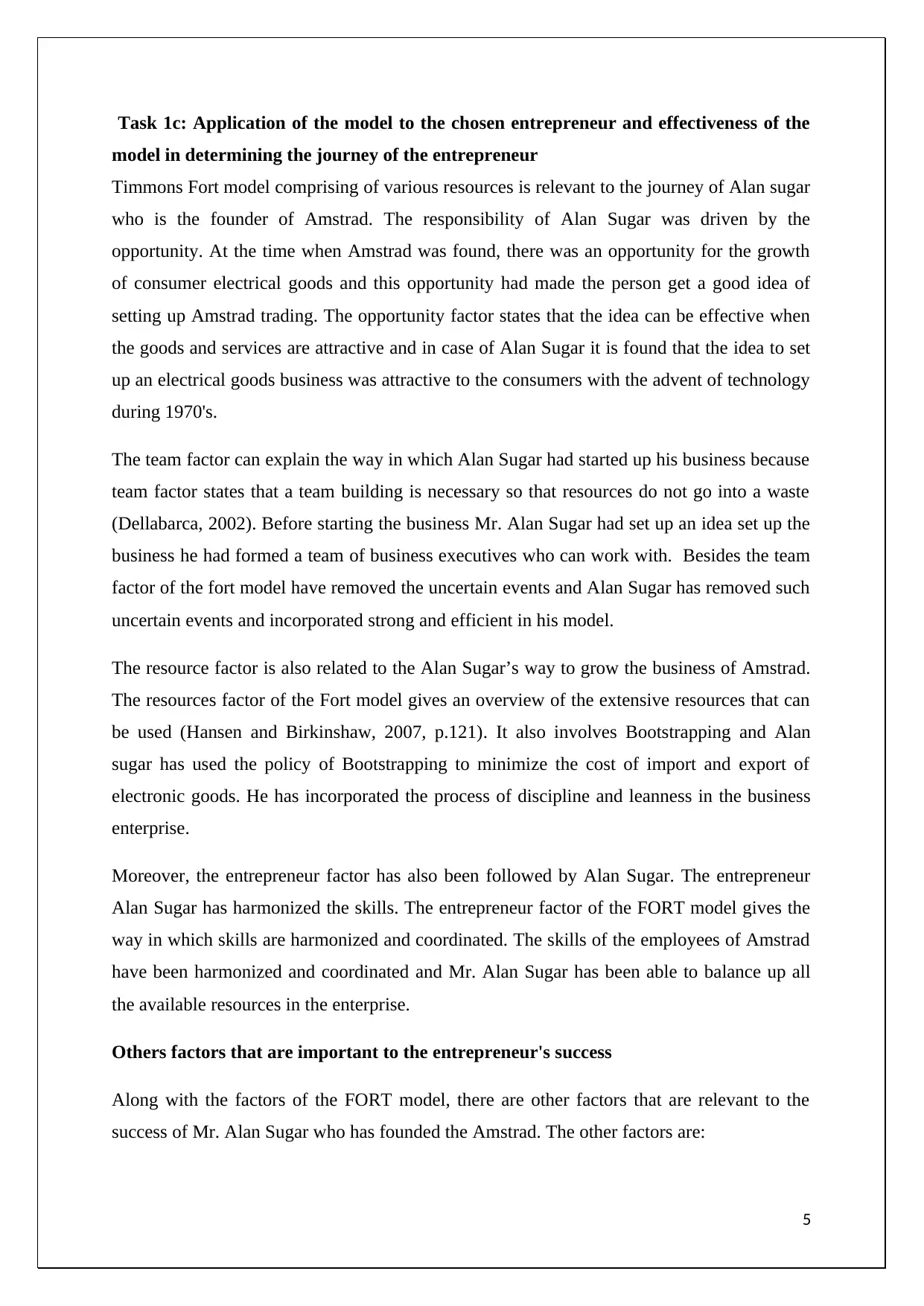
Task 1c: Application of the model to the chosen entrepreneur and effectiveness of the
model in determining the journey of the entrepreneur
Timmons Fort model comprising of various resources is relevant to the journey of Alan sugar
who is the founder of Amstrad. The responsibility of Alan Sugar was driven by the
opportunity. At the time when Amstrad was found, there was an opportunity for the growth
of consumer electrical goods and this opportunity had made the person get a good idea of
setting up Amstrad trading. The opportunity factor states that the idea can be effective when
the goods and services are attractive and in case of Alan Sugar it is found that the idea to set
up an electrical goods business was attractive to the consumers with the advent of technology
during 1970's.
The team factor can explain the way in which Alan Sugar had started up his business because
team factor states that a team building is necessary so that resources do not go into a waste
(Dellabarca, 2002). Before starting the business Mr. Alan Sugar had set up an idea set up the
business he had formed a team of business executives who can work with. Besides the team
factor of the fort model have removed the uncertain events and Alan Sugar has removed such
uncertain events and incorporated strong and efficient in his model.
The resource factor is also related to the Alan Sugar’s way to grow the business of Amstrad.
The resources factor of the Fort model gives an overview of the extensive resources that can
be used (Hansen and Birkinshaw, 2007, p.121). It also involves Bootstrapping and Alan
sugar has used the policy of Bootstrapping to minimize the cost of import and export of
electronic goods. He has incorporated the process of discipline and leanness in the business
enterprise.
Moreover, the entrepreneur factor has also been followed by Alan Sugar. The entrepreneur
Alan Sugar has harmonized the skills. The entrepreneur factor of the FORT model gives the
way in which skills are harmonized and coordinated. The skills of the employees of Amstrad
have been harmonized and coordinated and Mr. Alan Sugar has been able to balance up all
the available resources in the enterprise.
Others factors that are important to the entrepreneur's success
Along with the factors of the FORT model, there are other factors that are relevant to the
success of Mr. Alan Sugar who has founded the Amstrad. The other factors are:
5
model in determining the journey of the entrepreneur
Timmons Fort model comprising of various resources is relevant to the journey of Alan sugar
who is the founder of Amstrad. The responsibility of Alan Sugar was driven by the
opportunity. At the time when Amstrad was found, there was an opportunity for the growth
of consumer electrical goods and this opportunity had made the person get a good idea of
setting up Amstrad trading. The opportunity factor states that the idea can be effective when
the goods and services are attractive and in case of Alan Sugar it is found that the idea to set
up an electrical goods business was attractive to the consumers with the advent of technology
during 1970's.
The team factor can explain the way in which Alan Sugar had started up his business because
team factor states that a team building is necessary so that resources do not go into a waste
(Dellabarca, 2002). Before starting the business Mr. Alan Sugar had set up an idea set up the
business he had formed a team of business executives who can work with. Besides the team
factor of the fort model have removed the uncertain events and Alan Sugar has removed such
uncertain events and incorporated strong and efficient in his model.
The resource factor is also related to the Alan Sugar’s way to grow the business of Amstrad.
The resources factor of the Fort model gives an overview of the extensive resources that can
be used (Hansen and Birkinshaw, 2007, p.121). It also involves Bootstrapping and Alan
sugar has used the policy of Bootstrapping to minimize the cost of import and export of
electronic goods. He has incorporated the process of discipline and leanness in the business
enterprise.
Moreover, the entrepreneur factor has also been followed by Alan Sugar. The entrepreneur
Alan Sugar has harmonized the skills. The entrepreneur factor of the FORT model gives the
way in which skills are harmonized and coordinated. The skills of the employees of Amstrad
have been harmonized and coordinated and Mr. Alan Sugar has been able to balance up all
the available resources in the enterprise.
Others factors that are important to the entrepreneur's success
Along with the factors of the FORT model, there are other factors that are relevant to the
success of Mr. Alan Sugar who has founded the Amstrad. The other factors are:
5

An increase in business operations- Mr. Alan Sugar has enjoyed the formation and the
growth of his business which had helped him in becoming a successful entrepreneur. He
widened his scope of operations from personal computers to keyboards and then various
models of CPC. From personal computers, Alan Sugar focussed on the portable computer in
1990,s and such increase in products has led to the success.
Passionate in growing the business- Mr. Alan Sugar had the passion of increasing his
business he increased his business Amstrad by entering public trading in the year 1980's and
which had led to increase in the size of the business each year (Walker and Brown, 2004,
p.577). It is seen that from 1980's the business of Amstrad doubled each year as it got
registered on the London Stock exchange.
Consistency- The other factor which had led to the success of the entrepreneur was
consistency (Baron, 2000, p.15). It is found that from the beginning Alan Sugar had focussed
on technology only. He did not change the nature of the business. He consistently operated
on electronic gadgets and computers.
Task 1d: Conclusion of successfully launching and growing into a new venture
From the research, it is known to me that an entrepreneur has to have certain skills and will
have to keep in mind certain factors which can help him or her to grow his business. In order
to become a successful entrepreneur and launch and grow a new venture one has to keep in
mind factors that are defined by the FORT'S model which considers four different factors.
Alan Sugar is a successful entrepreneur who has followed the model and is successful in
establishing himself as an entrepreneur. Along with the factors of the Fort model the
entrepreneur has certain external factors that have helped him to set up his entity Amstrad
and become successful as an entrepreneur.
6
growth of his business which had helped him in becoming a successful entrepreneur. He
widened his scope of operations from personal computers to keyboards and then various
models of CPC. From personal computers, Alan Sugar focussed on the portable computer in
1990,s and such increase in products has led to the success.
Passionate in growing the business- Mr. Alan Sugar had the passion of increasing his
business he increased his business Amstrad by entering public trading in the year 1980's and
which had led to increase in the size of the business each year (Walker and Brown, 2004,
p.577). It is seen that from 1980's the business of Amstrad doubled each year as it got
registered on the London Stock exchange.
Consistency- The other factor which had led to the success of the entrepreneur was
consistency (Baron, 2000, p.15). It is found that from the beginning Alan Sugar had focussed
on technology only. He did not change the nature of the business. He consistently operated
on electronic gadgets and computers.
Task 1d: Conclusion of successfully launching and growing into a new venture
From the research, it is known to me that an entrepreneur has to have certain skills and will
have to keep in mind certain factors which can help him or her to grow his business. In order
to become a successful entrepreneur and launch and grow a new venture one has to keep in
mind factors that are defined by the FORT'S model which considers four different factors.
Alan Sugar is a successful entrepreneur who has followed the model and is successful in
establishing himself as an entrepreneur. Along with the factors of the Fort model the
entrepreneur has certain external factors that have helped him to set up his entity Amstrad
and become successful as an entrepreneur.
6
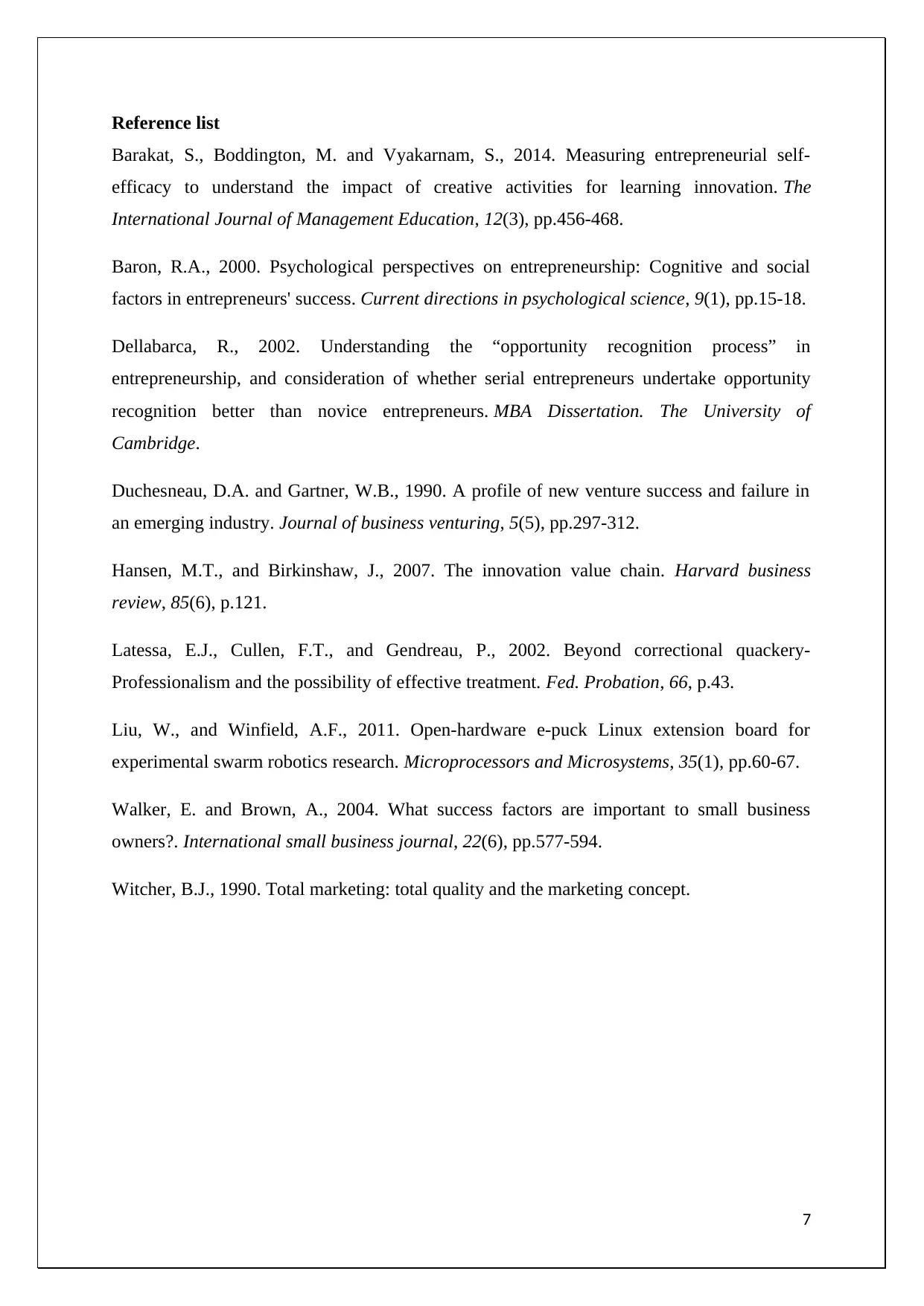
Reference list
Barakat, S., Boddington, M. and Vyakarnam, S., 2014. Measuring entrepreneurial self-
efficacy to understand the impact of creative activities for learning innovation. The
International Journal of Management Education, 12(3), pp.456-468.
Baron, R.A., 2000. Psychological perspectives on entrepreneurship: Cognitive and social
factors in entrepreneurs' success. Current directions in psychological science, 9(1), pp.15-18.
Dellabarca, R., 2002. Understanding the “opportunity recognition process” in
entrepreneurship, and consideration of whether serial entrepreneurs undertake opportunity
recognition better than novice entrepreneurs. MBA Dissertation. The University of
Cambridge.
Duchesneau, D.A. and Gartner, W.B., 1990. A profile of new venture success and failure in
an emerging industry. Journal of business venturing, 5(5), pp.297-312.
Hansen, M.T., and Birkinshaw, J., 2007. The innovation value chain. Harvard business
review, 85(6), p.121.
Latessa, E.J., Cullen, F.T., and Gendreau, P., 2002. Beyond correctional quackery-
Professionalism and the possibility of effective treatment. Fed. Probation, 66, p.43.
Liu, W., and Winfield, A.F., 2011. Open-hardware e-puck Linux extension board for
experimental swarm robotics research. Microprocessors and Microsystems, 35(1), pp.60-67.
Walker, E. and Brown, A., 2004. What success factors are important to small business
owners?. International small business journal, 22(6), pp.577-594.
Witcher, B.J., 1990. Total marketing: total quality and the marketing concept.
7
Barakat, S., Boddington, M. and Vyakarnam, S., 2014. Measuring entrepreneurial self-
efficacy to understand the impact of creative activities for learning innovation. The
International Journal of Management Education, 12(3), pp.456-468.
Baron, R.A., 2000. Psychological perspectives on entrepreneurship: Cognitive and social
factors in entrepreneurs' success. Current directions in psychological science, 9(1), pp.15-18.
Dellabarca, R., 2002. Understanding the “opportunity recognition process” in
entrepreneurship, and consideration of whether serial entrepreneurs undertake opportunity
recognition better than novice entrepreneurs. MBA Dissertation. The University of
Cambridge.
Duchesneau, D.A. and Gartner, W.B., 1990. A profile of new venture success and failure in
an emerging industry. Journal of business venturing, 5(5), pp.297-312.
Hansen, M.T., and Birkinshaw, J., 2007. The innovation value chain. Harvard business
review, 85(6), p.121.
Latessa, E.J., Cullen, F.T., and Gendreau, P., 2002. Beyond correctional quackery-
Professionalism and the possibility of effective treatment. Fed. Probation, 66, p.43.
Liu, W., and Winfield, A.F., 2011. Open-hardware e-puck Linux extension board for
experimental swarm robotics research. Microprocessors and Microsystems, 35(1), pp.60-67.
Walker, E. and Brown, A., 2004. What success factors are important to small business
owners?. International small business journal, 22(6), pp.577-594.
Witcher, B.J., 1990. Total marketing: total quality and the marketing concept.
7
Paraphrase This Document
Need a fresh take? Get an instant paraphrase of this document with our AI Paraphraser

8
1 out of 8
Your All-in-One AI-Powered Toolkit for Academic Success.
+13062052269
info@desklib.com
Available 24*7 on WhatsApp / Email
![[object Object]](/_next/static/media/star-bottom.7253800d.svg)
Unlock your academic potential
© 2024 | Zucol Services PVT LTD | All rights reserved.


